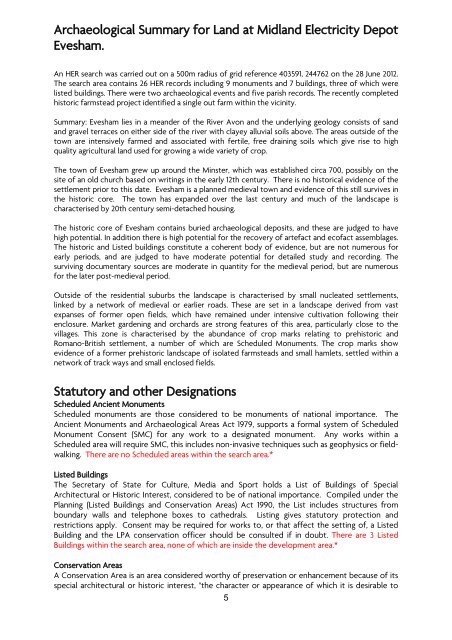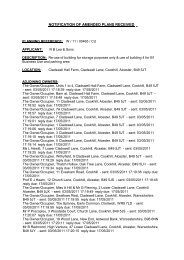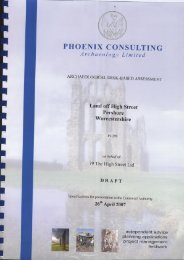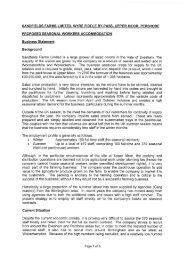Historic Environment Record Search - Wychavon District Council
Historic Environment Record Search - Wychavon District Council
Historic Environment Record Search - Wychavon District Council
You also want an ePaper? Increase the reach of your titles
YUMPU automatically turns print PDFs into web optimized ePapers that Google loves.
Archaeological Summary for Land at Midland Electricity Depot<br />
Evesham.<br />
An HER search was carried out on a 500m radius of grid reference 403591, 244762 on the 28 June 2012.<br />
The search area contains 26 HER records including 9 monuments and 7 buildings, three of which were<br />
listed buildings. There were two archaeological events and five parish records. The recently completed<br />
historic farmstead project identified a single out farm within the vicinity.<br />
Summary: Evesham lies in a meander of the River Avon and the underlying geology consists of sand<br />
and gravel terraces on either side of the river with clayey alluvial soils above. The areas outside of the<br />
town are intensively farmed and associated with fertile, free draining soils which give rise to high<br />
quality agricultural land used for growing a wide variety of crop.<br />
The town of Evesham grew up around the Minster, which was established circa 700, possibly on the<br />
site of an old church based on writings in the early 12th century. There is no historical evidence of the<br />
settlement prior to this date. Evesham is a planned medieval town and evidence of this still survives in<br />
the historic core. The town has expanded over the last century and much of the landscape is<br />
characterised by 20th century semi-detached housing.<br />
The historic core of Evesham contains buried archaeological deposits, and these are judged to have<br />
high potential. In addition there is high potential for the recovery of artefact and ecofact assemblages.<br />
The historic and Listed buildings constitute a coherent body of evidence, but are not numerous for<br />
early periods, and are judged to have moderate potential for detailed study and recording. The<br />
surviving documentary sources are moderate in quantity for the medieval period, but are numerous<br />
for the later post-medieval period.<br />
Outside of the residential suburbs the landscape is characterised by small nucleated settlements,<br />
linked by a network of medieval or earlier roads. These are set in a landscape derived from vast<br />
expanses of former open fields, which have remained under intensive cultivation following their<br />
enclosure. Market gardening and orchards are strong features of this area, particularly close to the<br />
villages. This zone is characterised by the abundance of crop marks relating to prehistoric and<br />
Romano-British settlement, a number of which are Scheduled Monuments. The crop marks show<br />
evidence of a former prehistoric landscape of isolated farmsteads and small hamlets, settled within a<br />
network of track ways and small enclosed fields.<br />
Statutory and other Designations<br />
Scheduled Ancient Monuments<br />
Scheduled monuments are those considered to be monuments of national importance. The<br />
Ancient Monuments and Archaeological Areas Act 1979, supports a formal system of Scheduled<br />
Monument Consent (SMC) for any work to a designated monument. Any works within a<br />
Scheduled area will require SMC, this includes non-invasive techniques such as geophysics or fieldwalking.<br />
There are no Scheduled areas within the search area.*<br />
Listed Buildings<br />
The Secretary of State for Culture, Media and Sport holds a List of Buildings of Special<br />
Architectural or <strong>Historic</strong> Interest, considered to be of national importance. Compiled under the<br />
Planning (Listed Buildings and Conservation Areas) Act 1990, the List includes structures from<br />
boundary walls and telephone boxes to cathedrals. Listing gives statutory protection and<br />
restrictions apply. Consent may be required for works to, or that affect the setting of, a Listed<br />
Building and the LPA conservation officer should be consulted if in doubt. There are 3 Listed<br />
Buildings within the search area, none of which are inside the development area.*<br />
Conservation Areas<br />
A Conservation Area is an area considered worthy of preservation or enhancement because of its<br />
special architectural or historic interest, "the character or appearance of which it is desirable to<br />
5






